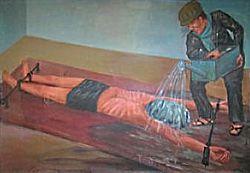A quick word on blocking ads

It looks like you are using an ad blocker. That's okay. Who doesn't? But without advertising revenue, we can't keep making this site awesome. Click the link below for instructions on disabling adblock.
Welcome to the Newschoolers forums! You may read the forums as a guest, however you must be a registered member to post. Register to become a member today!

Waterboarding is a torture technique that consists of immobilizing the victim on his or her back with the head inclined downwards; water is then poured over the face into breathing passages, causing the captive to believe he or she is dying.[1][2] In contrast to submerging the head face-forward in water, waterboarding precipitates an almost immediate gag reflex.[3] While the technique does not inevitably cause lasting physical damage, it can cause extreme pain, dry drowning, damage to lungs, brain damage from oxygen deprivation, other physical injuries including broken bones due to struggling against restraints, lasting psychological damage or, if uninterrupted, death.[4] Adverse physical consequences can manifest themselves months after the event, while psychological effects can last for years.[5]
In 2007 it was reported that the Central Intelligence Agency (CIA) was using waterboarding on extrajudicial prisoners and that the Department of Justice had authorized the procedure,[6][7] a revelation that sparked a worldwide political scandal. Al-Qaeda suspects upon whom the CIA is known to have used waterboarding are Khalid Sheikh Mohammed, Abu Zubaydah, and Abd al-Rahim al-Nashiri.[8][9] According to Justice Department documents, the waterboarding of Khalid Sheik Mohammed provided information about a potential 9/11-type attack on Los Angeles.[10]
U.S. government officials have at various times said they do not believe waterboarding to be a form of torture.[11][12][13][14] To justify its use of waterboarding, the administration of George W. Bush issued classified legal opinions that argued for a narrow definition of torture under U.S. law, including the Bybee memo, which it later withdrew.[15][16][17] In January 2009 President Barack Obama banned the use of waterboarding. In April 2009, the U.S. Department of Defense refused to say whether waterboarding is still used for training (e.g., SERE) purposes.[10][18]